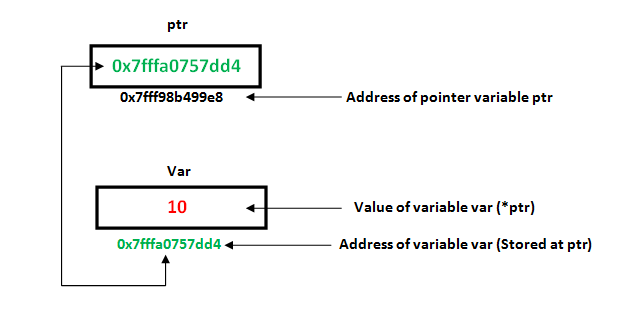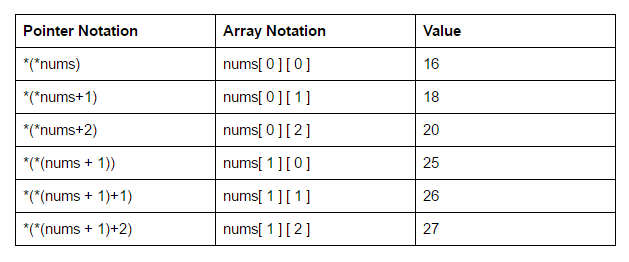
Pointers are symbolic representations of addresses. They enable programs to simulate call-by-reference as well as to create and manipulate dynamic data structures. Iterating over elements in arrays or other data structures is one of the main use of pointers.
The address of the variable you’re working with is assigned to the pointer variable that points to the same data type (such as an int or string).
Syntax:
datatype *var_name; int *ptr; // ptr can point to an address which holds int data

The reason we associate data type with a pointer is that it knows how many bytes the data is stored in . When we increment a pointer, we increase the pointer by the size of the data type to which it points.

Value at ptr = 0x7ffe454c08cc Value at var = 20 Value at *ptr = 20
There are 3 ways to pass C++ arguments to a function:
address of n1 in main(): 0x7fffa7e2de64 address of n1 in square1(): 0x7fffa7e2de4c Square of n1: 64 No change in n1: 8 address of n2 in main(): 0x7fffa7e2de68 address of n2 in square2(): 0x7fffa7e2de68 Square of n2: 64 Change reflected in n2: 64 address of n3 in main(): 0x7fffa7e2de6c address of n3 in square3(): 0x7fffa7e2de6c Square of n3: 64 Change reflected in n3: 64
In C++, by default arguments are passed by value and the changes made in the called function will not reflect in the passed variable. The changes are made into a clone made by the called function. If wish to modify the original copy directly (especially in passing huge object or array) and/or avoid the overhead of cloning, we use pass-by-reference. Pass-by-Reference with Reference Arguments does not require any clumsy syntax for referencing and dereferencing.
An array name contains the address of the first element of the array which acts like a constant pointer. It means, the address stored in the array name can’t be changed. For example, if we have an array named val then val and &val[0] can be used interchangeably.
Elements of the array are: 5 10 20

If pointer ptr is sent to a function as an argument, the array val can be accessed in a similar fashion. Pointer vs Array
A limited set of arithmetic operations can be performed on pointers which are:
( Note: Pointer arithmetic is meaningless unless performed on an array.)
Value at ptr = 0x7ffe5a2d8060 Value at *ptr = 10 Value at ptr = 0x7ffe5a2d8064 Value at *ptr = 100 Value at ptr = 0x7ffe5a2d8068 Value at *ptr = 200

Consider pointer notation for the two-dimensional numeric arrays. consider the following declaration
int nums[2][3] = < < 16, 18, 20 >, < 25, 26, 27 >>;
In general, nums[ i ][ j ] is equivalent to *(*(nums+i)+j)

String literals are arrays containing null-terminated character sequences. String literals are arrays of type character plus terminating null-character, with each of the elements being of type const char (as characters of string can’t be modified).
This declares an array with the literal representation for “geek”, and then a pointer to its first element is assigned to ptr. If we imagine that “geek” is stored at the memory locations that start at address 1800, we can represent the previous declaration as:

As pointers and arrays behave in the same way in expressions, ptr can be used to access the characters of a string literal. For example:
char ptr = 0;
char x = *(ptr+3); char y = ptr[3];
Here, both x and y contain k stored at 1803 (1800+3).
In C++, we can create a pointer to a pointer that in turn may point to data or another pointer. The syntax simply requires the unary operator (*) for each level of indirection while declaring the pointer.
char a; char *b; char ** c; a = ’g’; b = &a; c = &b;
Here b points to a char that stores ‘g’ and c points to the pointer b.
This is a special type of pointer available in C++ which represents the absence of type. Void pointers are pointers that point to a value that has no type (and thus also an undetermined length and undetermined dereferencing properties). This means that void pointers have great flexibility as they can point to any data type. There is a payoff for this flexibility. These pointers cannot be directly dereferenced. They have to be first transformed into some other pointer type that points to a concrete data type before being dereferenced.
*data points to a char The new value of c is: y *data points to an int The new value of i is: 11
A pointer should point to a valid address but not necessarily to valid elements (like for arrays). These are called invalid pointers. Uninitialized pointers are also invalid pointers.
int *ptr1; int arr[10]; int *ptr2 = arr+20;
Here, ptr1 is uninitialized so it becomes an invalid pointer and ptr2 is out of bounds of arr so it also becomes an invalid pointer. (Note: invalid pointers do not necessarily raise compile errors)
A null pointer is a pointer that point nowhere and not just an invalid address. Following are 2 methods to assign a pointer as NULL;
int *ptr1 = 0; int *ptr2 = NULL;
Related Articles:
Quizzes: